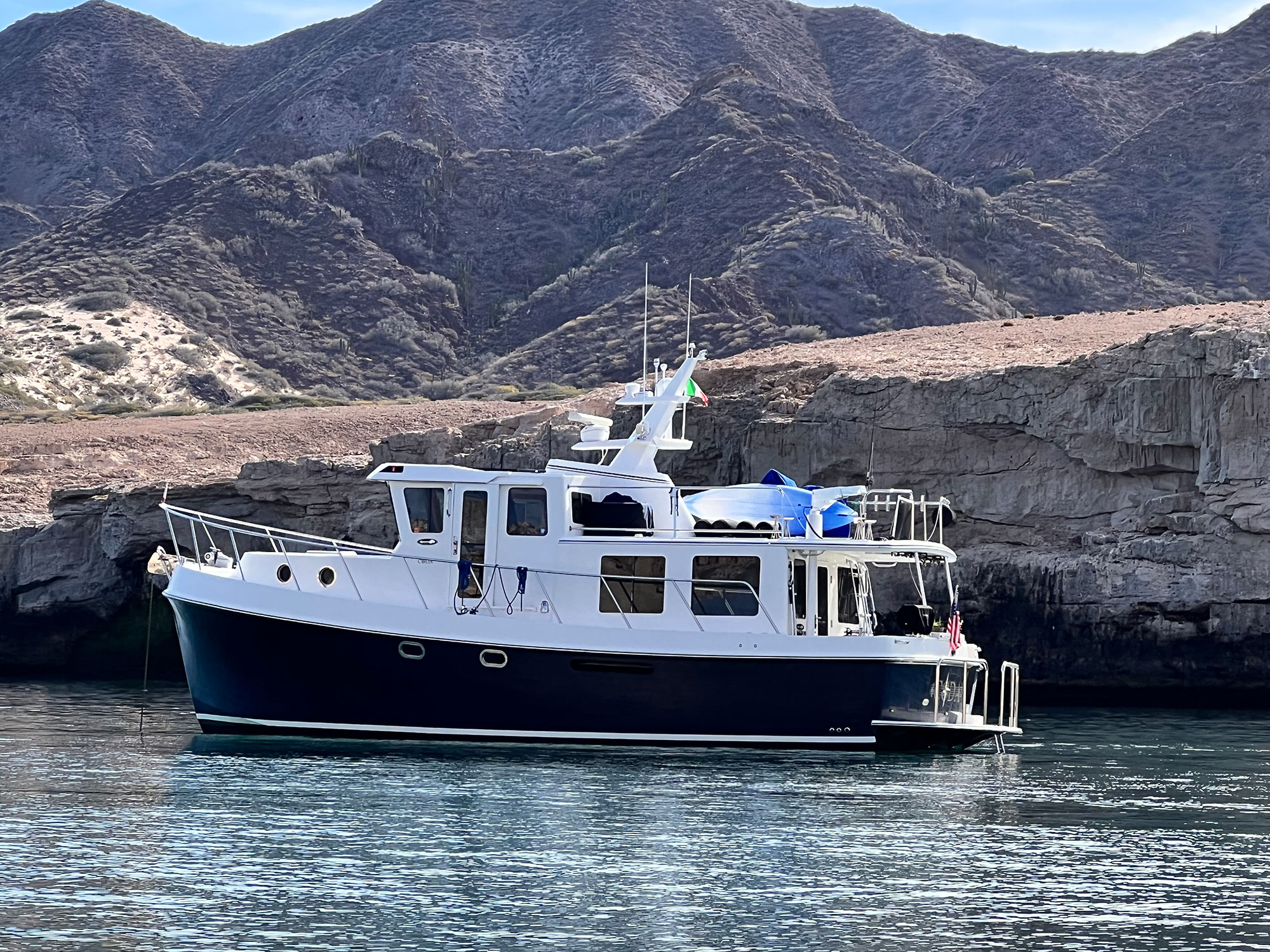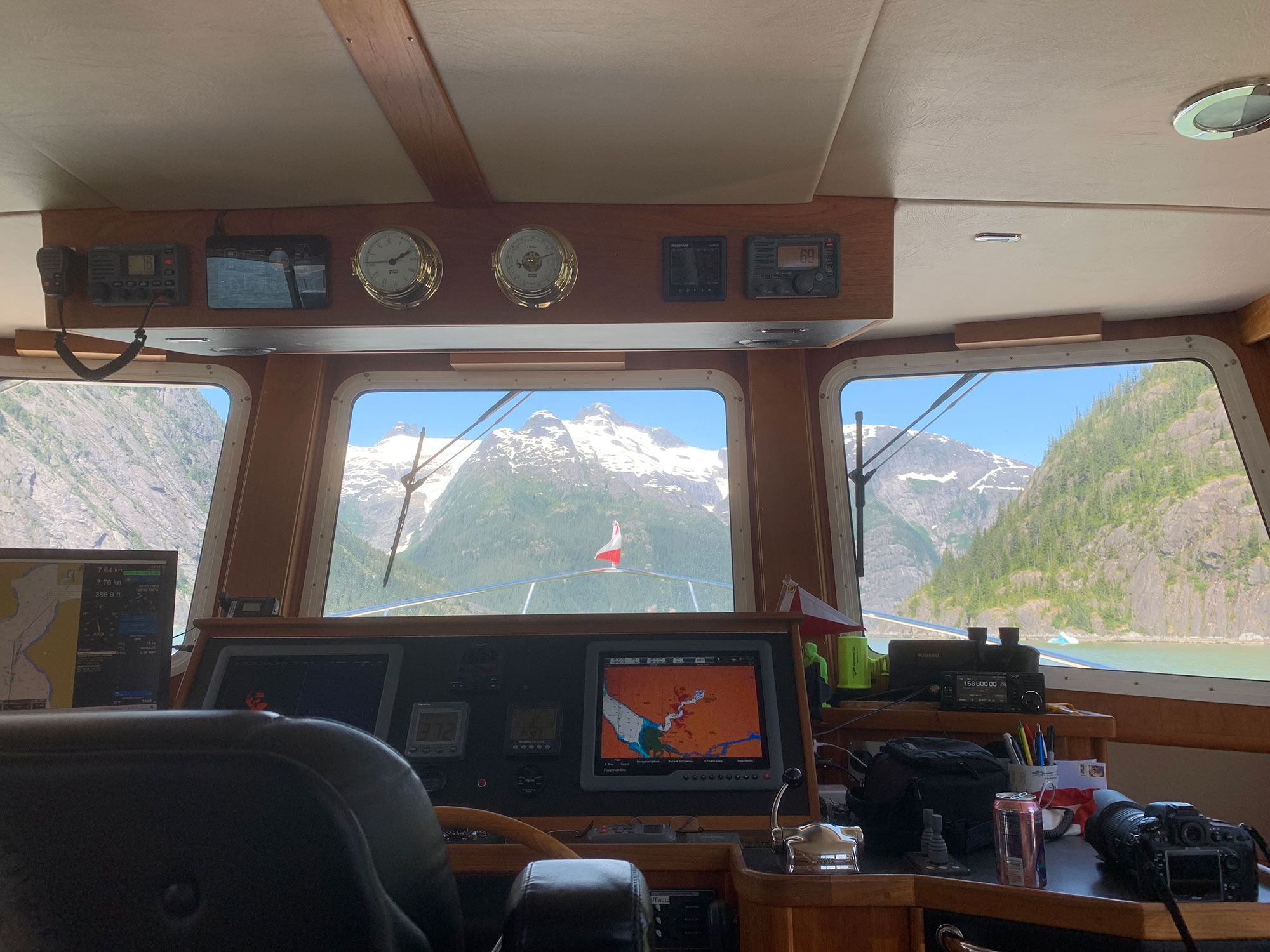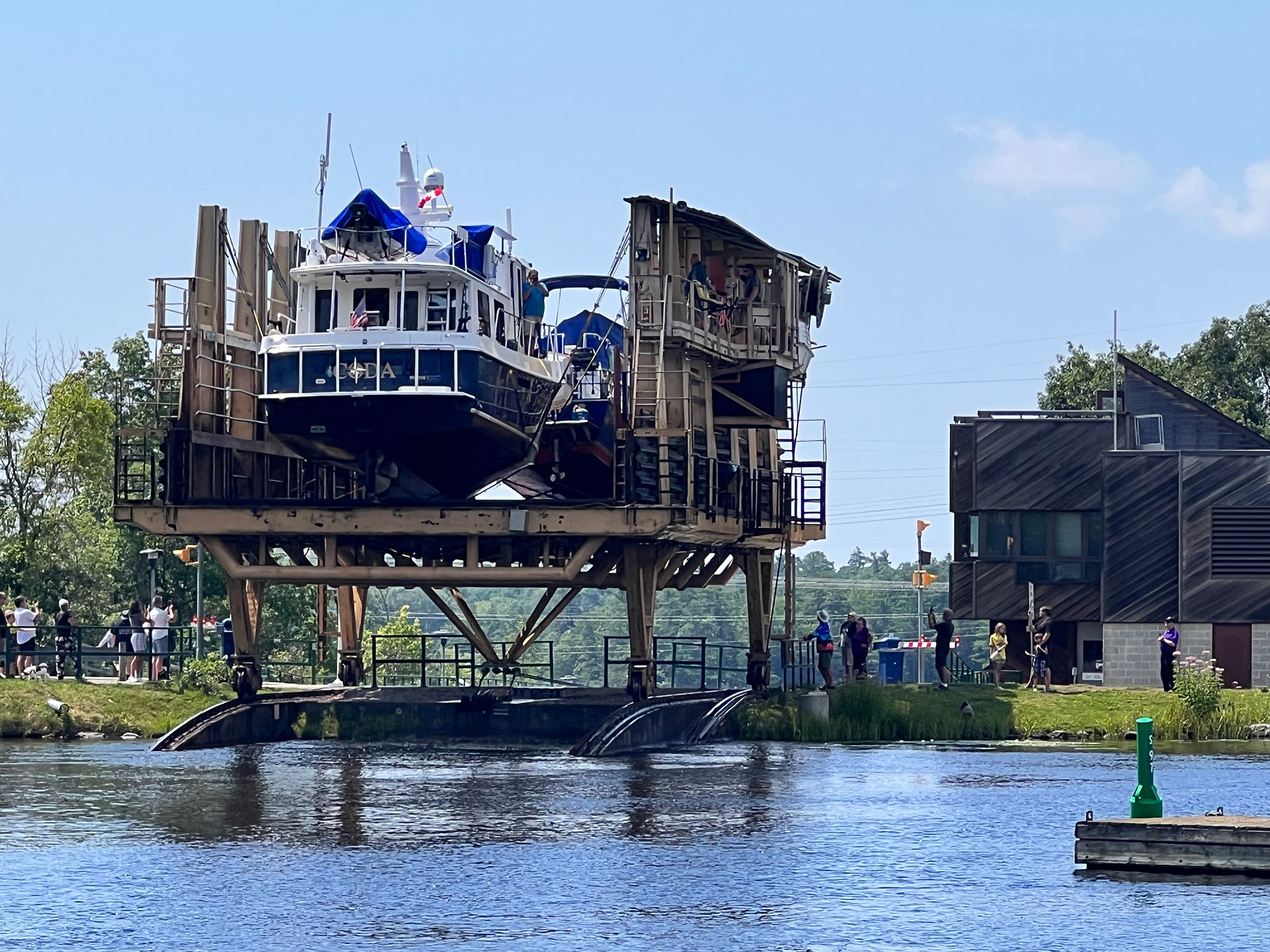Liveaboard Olsson doesn’t skip a beat when pinpointing what drove him to cruise more than 22,000 nautical miles over the last few years—roughly the circumference of Earth, he mentions—aboard Coda, his 2008 American Tug 41.
It was a recollection from the summer of 1967, and while many Californians opted for a casual vacation of packing the kids in the car and heading to Disneyland, the Olssons, who included dad Dan, mom Dorine, youngster Steve, sisters Barb and Wynn and toddler brother Gary, set out for a month of adventure aboard a 34-foot converted steel workboat named DorDan (a combo of Dorine’s and Dan’s names), West Coast style.
“It was a pretty big deal,” Olsson recalls. “We did a lot of boating near our home in San Diego. We’d cruise to Catalina and to Mexico. I was about 10 when my father decided to take the family to San Francisco and back for a month. He was an engineer, very technical, a great navigator.”
“I remember that trip as just being amazing and fantastic and it was summer and we went up the Sacramento River,” he adds. “I vividly remember Morro Bay and going under the Golden Gate Bridge. I remember swimming ashore and picking blackberries and coming back and my mom would bake pie and all this stuff and it’s made me want to cruise my entire life.”
Life Gets in the Way, Or Paves the Way
In his child’s eye, what came after that momentous adventure and others was affirmation of a dream. As Olsson matured, the path to that dream became a guide for living, and he followed in his father’s footsteps professionally and personally to deepen his relationship with the water. After studying to become an engineer, focusing on software, radar and navigation systems, he worked for the Hughes Aircraft Company, all the while continuing to cruise off San Diego as well as on inland freshwater lakes.
Professional opportunities with Microsoft as well as with military software and hardware producers resulted in a move to Washington state, where he resumed his water-based exploring in the San Juan Islands and as far north as Canada’s Broughton Archipelago. He joined the Meydenbauer Bay Yacht Club in Bellevue, Washington, and met and cruised with other members. He took classes offered by the United States Power Squadrons, from basic seamanship to celestial navigation; he also taught classes for the organization.
Throughout, he bought boats: first, a 16-foot ski boat out of college; then a couple of Sea Rays in the 20-foot range; a 50-foot custom trawler converted from a fishing boat named Maverick, which he thought was his “forever” boat. He also earned a 100-ton master captain’s license from the U.S. Coast Guard.
As he continued gaining hands-on experience, clicking off the nautical miles and forming a “someday” plan, he had second thoughts about Maverick. “It was a converted trawler, and it was one-off, a very interesting boat,” Steve recalls, “but all this time I really wanted an American Tug. I just love the boat.”
About a dozen years earlier, Olsson had made the trip to La Conner, Washington, and took a tour of the American Tug factory. He couldn’t get the seaworthy American Tug models, based on the rugged, reliable hulls used in the Alaska salmon fishery, out of his mind.
Meanwhile, he was also having second thoughts about the working life.


Epiphany at Rose Point
After retiring from 20 years with Microsoft, Olsson started his own company, building software and hardware interfaces for NMEA 2000, the marine-electronics network protocol. This led to a client relationship with Rose Point Navigation in Redmond, Washington, and eventually, Olsson went to work there.
“I used to just look at the charts and think, ‘Oh my God,’ I really want to go there,” he says, adding, “and I would read about people who were going to Mexico and think, ‘Man, that is just awesome.’ I decided that, since my father worked so late in his career and was too sick to do much afterward, I’ve got to get going, I’ve got to follow my dream.”
And so, in his mid 60s, after working at Rose Point for three years, a timeline emerged: Retire in April 2021, shove off May 2021. There was only one problem: Olsson still needed the perfect boat.
The wait time for a new build at American Tug was two years when Olsson looked into it, and two years was too long. “I wanted to cruise,” he says. “I wanted adventure.”
Luck arrived in the form of a 2008 American Tug 41. Solidly built, it measures 43 feet 8 inches, with two cabins and en suite heads, which appealed to Olsson, who would cruise with sister Barbara as crew. Other priorities were that it would handle rough water conditions well and make efficient mileage.
Purchasing the tug in October 2020, Olsson gave himself at least six months for a shakedown to ensure everything was working, in part because the boat had sat on the hard for some time. About three weeks after the sale, the Volvo D9 engine, which had 2300 hours on it, failed, so Olsson replaced all the injectors and starter. “I wanted a reliable boat for this trip, I didn’t want to be the mechanic the whole way, so getting that done right out of the gate was a blessing in disguise. It was expensive but I met a really good mechanic and he really helped me get spare parts and set up to leave.”
After that, Olsson cut his ties to land, selling most of his possessions and moving aboard. Borrowing the Italian word that signifies a transition to the end of a musical passage or the completion of an entire score, He named the tug Coda to convey what the boat means to him: “My grand finale.”

Explore Where … with Who?
Olsson was intent on setting off, and while destinations mattered, he just wanted to be aboard and underway. Alaska and Mexico were high on his list; he mulled Europe, too. Yacht club friends Matt and Tonia Brown and Boris and Mayli Hodak insisted on the Great Loop, the vast waterway circle straddling the eastern United States and Canada. “I really never even heard of it before,” Olsson says. “I found it fascinating after doing some research. I told them all right, but I don’t want to leave here to do the Great Loop until I finally have my chance to go to Alaska.”
So much hinged on how well this excursion north came off. He’d informed family and friends, had agreed to take on Barbara as crew, though he had doubts because they’d not spent any time together since their teen years.
But Barbara too had owned boats, and Matt and Tonia buddy boated aboard their Navigator 53 Sudden Inspiration, lending Olsson the independence he craved.
Upon completion of the northern leg, some 3,200 nautical miles later and settled back temporarily in Seattle, Olsson recorded in a September 2021 blog entry: “Alaska was a stunning trip. The wildlife, the glaciers and the sheer distance made the trip so memorable. We made new friends and had great adventures. I highly recommend this trip as something everyone should consider. Glacier Bay was the highlight for me, but there were an incredible number of places that were great.”
The genie was out of the bottle. “We had an awesome time,” he says, adding, “Barbara fit in well as crew—it’s hard to singlehand on long journeys—we got along, we rafted with Matt and Tonia and anchored out almost every night on the trip.”
Rafting up with old friends, making new ones and exploring stunning and remote anchorages led to the big left turn down the U.S. West Coast toward Mexico—Olsson’s other longtime dream destination—in fall 2021. From then through winter 2022 voyaging high points ranged from motoring into San Francisco Bay, reuniting with the waters off San Diego, exploring the Golfo de California, also called the Sea of Cortez, which was “like boating in an aquarium, with great diving, great sea life, super-hot weather, strong winds and friendly, helpful people,” he says.
To satisfy rigorous insurance requirements during hurricane season in the summer of 2022, Olsson cooled off for three months at Marina Papagayo in Costa Rica, then transited the Panama Canal in fall. The second half of the extended adventure, the Great Loop, loomed large, and Olsson needed to keep moving.
“I didn’t really realize how far the trip was until I got down to Panama and thought, ‘Oh my God, I’ve come a long way,’ ” he says.
With a few more side excursions in their wake, including landfalls at the Las Perlas islands on the Pacific Ocean side of Panama, then the San Blas Islands on the Caribbean-Sea side of Panama, Jamaica, a destination 250 miles of open water away, was now where they pointed Coda’s bow.
“We did not plan to leave unless the weather was perfect,” Olsson says. “It was sunny and beautiful, but it was three pretty grueling days with only two people aboard. I didn’t get much sleep.”
Nonetheless, crew and Coda rallied; after all, the Great Loop and its 6,000 miles of waterway and prime sightseeing and scenic spots awaited. After Jamaica, and yet another fun-filled stopover in Grand Cayman, Coda arrived at Dry Tortugas National Park in Florida, then leapt into the Loop from Key West.
“The Great Loop is fairly easy,” Olsson says. “There were only a couple of times I really got shaken up.” After battling the elements en route to Cape Canaveral, Olsson ducked inside and transited the Intracoastal Waterway north to avoid strong Atlantic Ocean headwinds. Unforgettable moments from January 2023 through January 2024 include entering New York harbor, transiting the Erie Canal system, sightseeing in the Thousand Islands, using the locking system in the Trent-Severn Waterway, and last but not least: buddy boating with old friends Matt and Tonia and Boris and Mayli, and making new friends.
“We met some of the most wonderful people on that trip, people that I’m going to be lifelong friends with,” Olsson says. “For a while we were cruising with six boats together because we just kept meeting people who are awesome and fun to be with.”
And true to form, Olsson couldn’t resist adding a couple of side trips, and so, by the end of his Great Loop, the nautical miles were closer to 7,000.

Sunshine & Rainbows
Not every day of this larger-than-life voyaging adventure was sunshine and rainbows, and Olsson is clear about that aspect of the undertaking. It’s important to note that Matt was aboard for some of the legs and that Steve and Barbara took breaks away from the boat for periods of time, whether to tend to personal business or to reconnect with family and friends. Olsson also made sure he kept Coda on a tight maintenance schedule.
Through it all, he compliments the platform that to this day sees him and his dreams through.
“I have nothing but praise for this boat,” Olsson says. “It is really solid and well built. It has been amazingly good. The engine allows us to cruise at 7 1/2 to 8 knots at about 1,250 RPM. It burns about 2.7 gallons per hour, I have a 1,200-mile range, and it just runs and runs.” If he preferred, this American Tug can achieve a cruising speed of 10-12 knots, but Olsson preferred maximizing his range.
Belowdecks, he loves how comfortable the tug’s accommodations are, especially that this model offered up two cabins, each with a head.
“The boat is way tougher than I am,” he adds. “I came to the conclusion that after awhile, you get used to rocking, and so we had a procedure before ocean cruising. It includes shoving pillows in the cupboards that have dishes in them; bringing down all the wine bottles, wrapping them in towels; locking the doors; and adding locking knobs to the drawers and the cupboards.
“If we did all of those things then we could limit the noise, because the noise, when you hear things crashing, upsets you.”
After finishing the Loop in Marathon Key, Florida, Olsson moved Coda to Ft. Lauderdale and had her shipped back to Seattle.
“I’m living on the boat and deciding what to do next,” he says. “I will be doing local cruising while I figure that out. I will not sell Coda. We have a history together